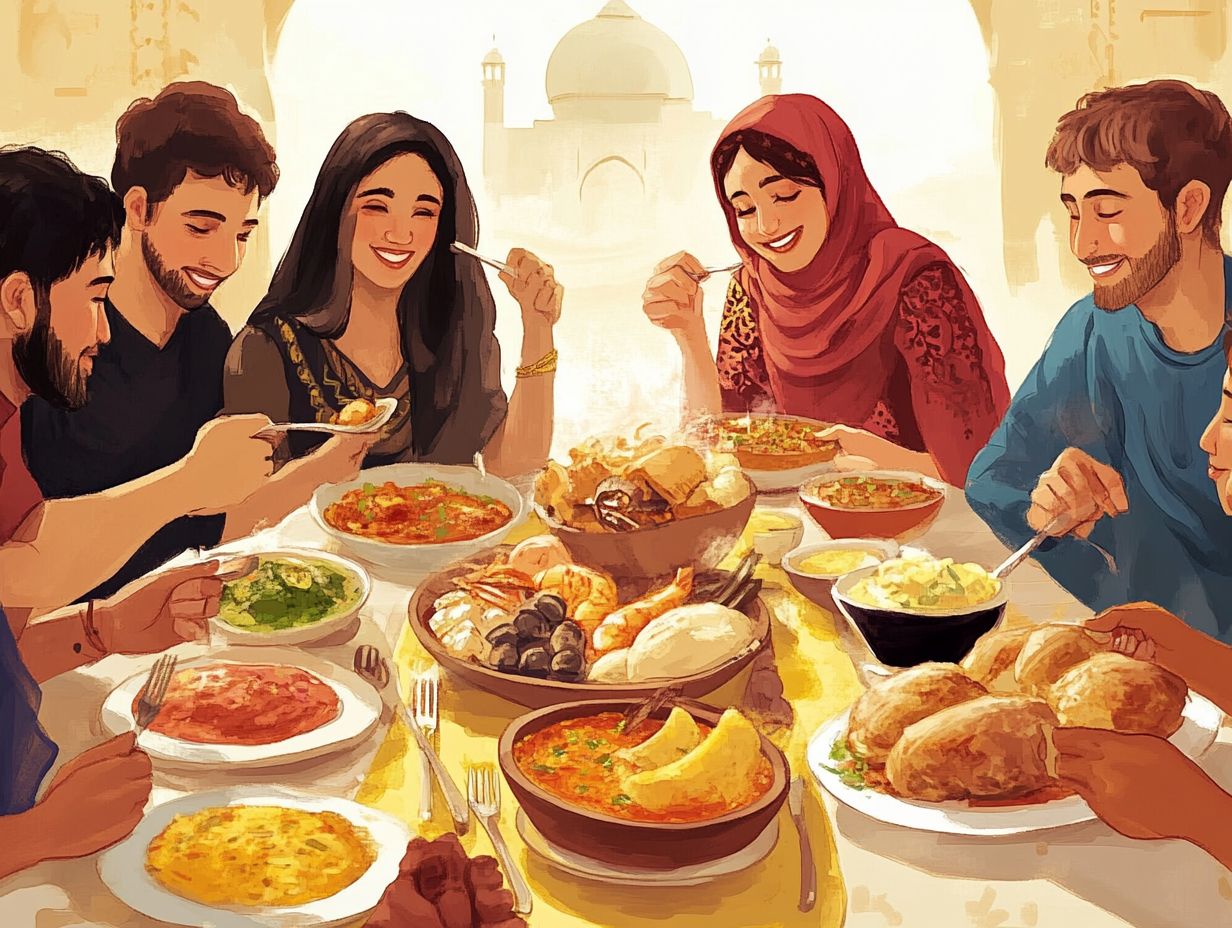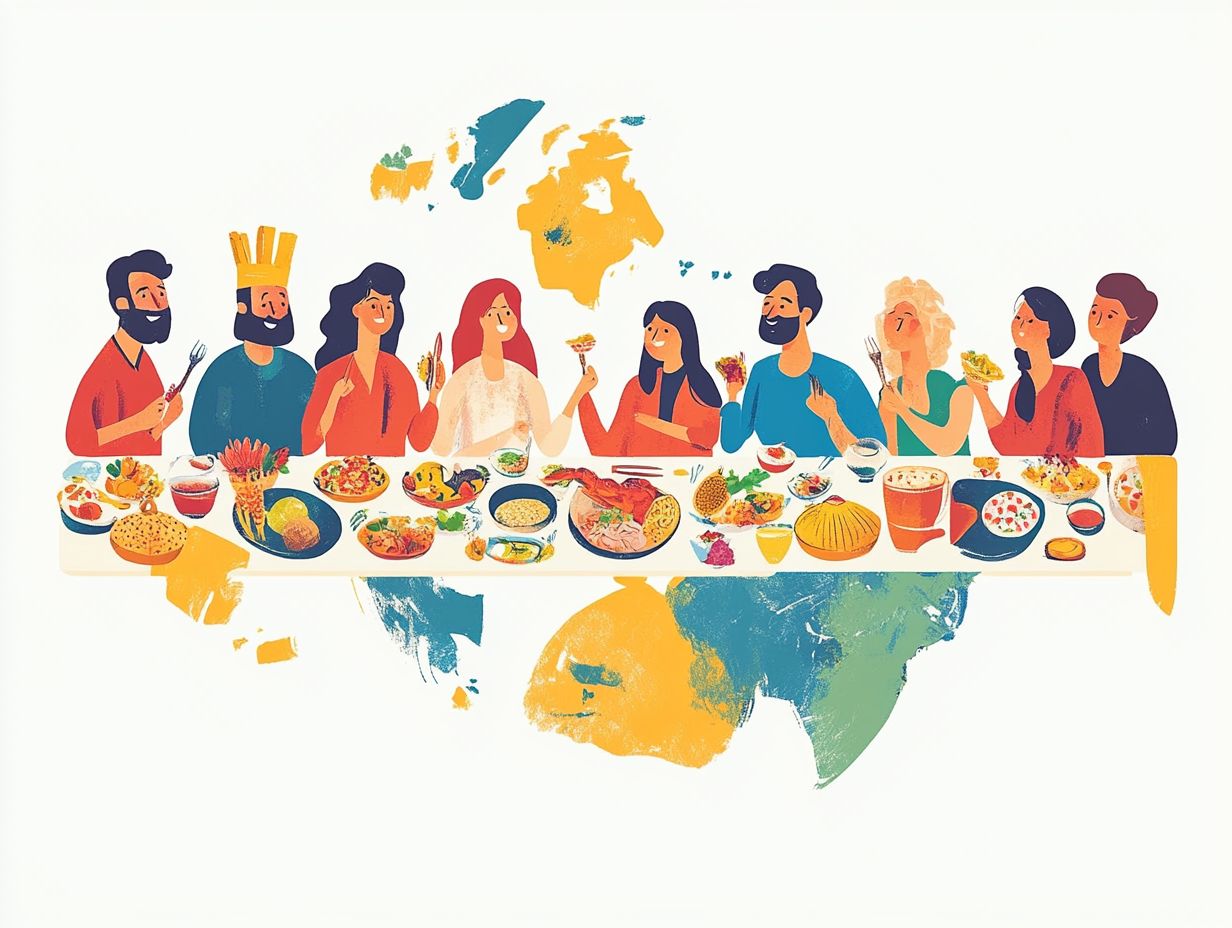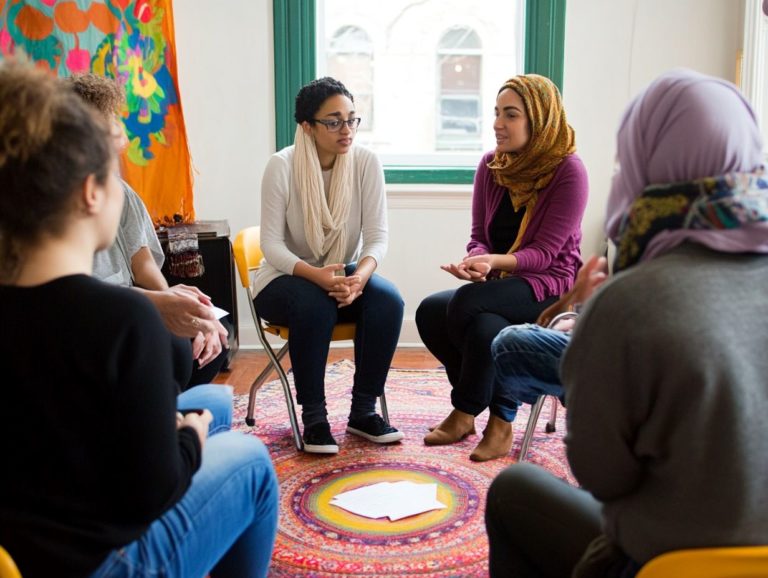Adapting Your Eating Habits to New Cultures
Adapting to new cultures can be an enriching experience, and food is often at the heart of that journey. This article delves into the significance of cultural adaptation through the lens of your eating habits.
You ll encounter challenges when adjusting to unfamiliar cuisines. However, you’ll also find practical strategies to embrace local flavors and ingredients.
Discover how these culinary changes can foster your cultural immersion and personal growth while enhancing your overall health and nutrition.
Dive in and explore this exciting culinary adventure!
Contents
- Key Takeaways:
- The Importance of Cultural Adaptation
- Challenges of Adapting to New Eating Habits
- Strategies for Adapting Your Eating Habits
- Benefits of Adapting to New Eating Habits
- Frequently Asked Questions
- 1. How can I adapt my eating habits to new cultures?
- 2. Will I have to give up my favorite foods when adapting to a new culture?
- 3. How can I navigate dietary restrictions when adapting to a new culture?
- 4. How can I maintain a healthy diet when adapting to a new culture?
- 5. What are some common mistakes to avoid when adapting your eating habits to new cultures?
- 6. How can I embrace and appreciate the new culture’s food while still staying true to my own cultural identity?
Key Takeaways:

- Understand the importance of cultural adaptation related to food and eating habits.
- Overcome challenges of adapting to new eating habits by researching, communicating, and trying new foods.
- Experience benefits of adapting to new eating habits, including cultural immersion, personal growth, and improved health.
The Importance of Cultural Adaptation
Cultural adaptation is vital. It benefits both you and your community, especially in today s connected world. Understanding diverse cultural practices can significantly enhance your daily routines and social interactions.
It acts as a bridge between distinct cultural identities. This allows families and societies to foster acceptance and appreciation, while artfully navigating complex political landscapes and economic dynamics.
By embracing cultural adaptation, you gain a deeper understanding of the importance of food as a fundamental aspect of human existence. This enriches your experiences and promotes a sense of survival and luxury in everyday life.
Understanding the Role of Food in Culture
Food holds a crucial position in shaping your cultural identity. It reflects the unique heritage and values of your society, facilitating survival and enriching humanity’s experience.
Food serves not just as nourishment but as a medium for expressing social norms and cultural practices. This is particularly evident in mixed cuisines, such as the Filipino food culture, where Spam and the beloved Jollibee illustrate how external influences blend into local traditions.
These culinary examples demonstrate how food intricately weaves into daily life and collective memory. It fosters a sense of belonging and connection within communities.
The incorporation of Spam into the Filipino diet showcases the adaptability of food traditions. It highlights how necessity can spark innovative dishes that resonate with your personal identity.
Jollibee is a symbol of national pride. It reflects not only the richness of Filipino flavors but also the embrace of global influences. This dynamic exchange within cuisines does more than satisfy hunger; it reinforces social norms and creates a vibrant tapestry of traditions that evolve to meet people’s ever-changing needs.
Challenges of Adapting to New Eating Habits
Adapting to new eating habits can be quite a journey, especially when you’re navigating cultural environments where food patterns and choices differ dramatically. For helpful advice, check out this guide on adapting to local cuisine.
These challenges can significantly affect families and overall health care, as traditional eating habits may not align with new dietary norms.
Food choices deeply rooted in cultural identity can create either resistance or acceptance. Understanding these dynamics is crucial to ease your transition.
Grasping this landscape empowers you to make choices that honor both your heritage and new surroundings.
Common Obstacles and How to Overcome Them

Common obstacles to embracing new food choices often arise from deeply ingrained habits and cultural preferences. These barriers can hinder your acceptance and appreciation of diverse culinary experiences. You might feel resistance to trying unfamiliar foods, lack understanding about their significance, or be unwilling to alter your established daily routines.
Holding onto familiar tastes and textures creates a comfort zone that can feel daunting to step outside of. Social pressures can also add to this, as family and friends may express skepticism or indifference towards new options, reinforcing your hesitations.
A practical strategy to navigate these challenges is to start small. Incorporate one new ingredient or dish at a time. This approach eases the transition and encourages a sense of exploration. Learning about the nutritional benefits and cultural significance of different foods can help you feel more open to trying exciting new culinary delights.
Strategies for Adapting Your Eating Habits
Implementing effective strategies can transform your eating habits and enhance your culinary experiences. This is especially important when engaging with local cuisines and cultivating cultural awareness.
By embracing the rich flavors and traditions of diverse culinary practices, you can expand your palate and deepen your appreciation of cultural identity.
This journey involves talking to locals and taking an open-minded approach to exploring new foods. These actions enrich your adaptation process.
Researching Local Cuisine and Ingredients
Researching local cuisine and ingredients is vital for adapting to new eating habits. It offers valuable insights into unique food patterns and cultural practices of the region.
Understanding how local ingredients are utilized in Filipino dishes or other regional specialties can help create a smoother transition and elevate your culinary experience. This creates a bridge between the familiar and the novel.
As you explore local flavors, you don t just learn about traditional dishes; you also uncover the rich stories and histories that accompany them. For instance, the use of coconut in Filipino specialties highlights sustainability and the abundance of resources found in the archipelago. Engaging with Italian cuisine reveals the importance of fresh, seasonal produce in crafting dishes that celebrate the land s bounty.
By embracing these culinary ways, you can appreciate the profound connection between food, culture, and community. This paves the way for healthier eating habits that honor local traditions.
Communicating with Locals and Trying New Foods
Engaging with locals and savoring new foods will transform your cultural adaptation journey. This allows you to cultivate a genuine appreciation for diverse culinary traditions. When you connect with individuals who understand the cultural significance of the dishes they prepare, you gain valuable insights and make informed dietary choices that respect their cultural identities.
This interaction expands your palate and unveils the stories behind each dish, reflecting the values and history of the community. Sharing a traditional paella in Spain can provide fascinating insights into regional ingredients and communal dining practices.
These experiences invite you to appreciate the artistry and heritage embedded in every meal. Embracing local delicacies fosters a sense of belonging, making your transition smoother and more enriching. Culinary exploration often serves as a gateway to deeper cultural understanding.
Benefits of Adapting to New Eating Habits

Adapting to new eating habits offers benefits that go far beyond just flavor; it profoundly influences your cultural immersion and personal growth.
By embracing diverse food traditions, you broaden your cooking skills and gain invaluable insights into cultural identities. This journey enriches your social life while enhancing your overall health and nutrition.
Cultural Immersion and Personal Growth
Cultural immersion through food can inspire remarkable personal growth, allowing you to appreciate traditions beyond your own. This adventure opens your heart to the beauty of diversity and cultivates a deeper understanding of how food connects people across different backgrounds, enhancing your interpersonal relationships.
As you explore the culinary practices of various cultures, you ll uncover a rich tapestry of stories woven into each dish. Sharing a meal in a different cultural setting can break down barriers, inviting conversations that reveal personal narratives and shared experiences. Picture yourself savoring the spices of Indian cuisine while engaging with a local family. This experience broadens your palate and deepens your empathy and respect for others’ life experiences.
These moments show how food can transform connections and create community.
Improved Health and Nutrition
Adapting to new eating habits can significantly enhance your health and nutrition. Embracing different cuisines adds beneficial protein sources to your diet. As you explore various culinary practices, you expand your dietary variety, supporting your overall well-being and longevity.
This exploration invites unique flavors into your meals while ensuring you incorporate essential nutrients crucial for maintaining energy levels and muscle health. Discovering plant-based proteins proteins that come from plants, like beans and lentils alongside lean meats and seafood can boost your daily protein intake. Integrating traditional cuisines that emphasize wholesome ingredients offers a balanced approach to nutrition, leading to benefits such as improved digestion and enhanced heart health.
Celebrating diverse food cultures presents a wonderful opportunity for lifelong learning, promoting a sustainable and enjoyable way to nourish both your body and mind.
Frequently Asked Questions
1. How can I adapt my eating habits to new cultures?

To adapt your eating habits to new cultures, research and understand the customs and traditions surrounding food. This knowledge helps you discover what types of foods are commonly eaten and how they are prepared. For a deeper insight, explore food culture: embracing local cuisine abroad and be open to trying new foods and flavors.
2. Will I have to give up my favorite foods when adapting to a new culture?
Not necessarily. While you may not find your exact favorite foods, you can discover similar alternatives or learn to prepare your favorite dishes using local ingredients. Don t be afraid to experiment and mix flavors from your home country with those of the new culture.
If you have dietary restrictions, communicate them clearly when dining with locals or ordering food. Learn how to express your restrictions in the local language and be open to trying new dishes that accommodate your needs. Research local dishes that are naturally free from your restricted ingredients.
4. How can I maintain a healthy diet when adapting to a new culture?
Maintaining a healthy diet while adapting to a new culture takes effort.
Look for fresh, local ingredients and add a variety of fruits and vegetables into your meals.
It is also helpful to be mindful of portion sizes and limit your intake of processed foods.
5. What are some common mistakes to avoid when adapting your eating habits to new cultures?
One common mistake is assuming that all dishes in a new culture will be spicy or exotic.
Be adventurous! Explore various dishes without hesitation.
Avoid comparing the new food to your home country’s cuisine and remember that every culture has its own unique flavors and traditions.
6. How can I embrace and appreciate the new culture’s food while still staying true to my own cultural identity?
Embrace the new culture’s food by learning about the history and significance behind certain dishes.
This understanding can deepen your appreciation.
Try to include flavors from your home cooking while discovering the amazing flavors of your new culture!





